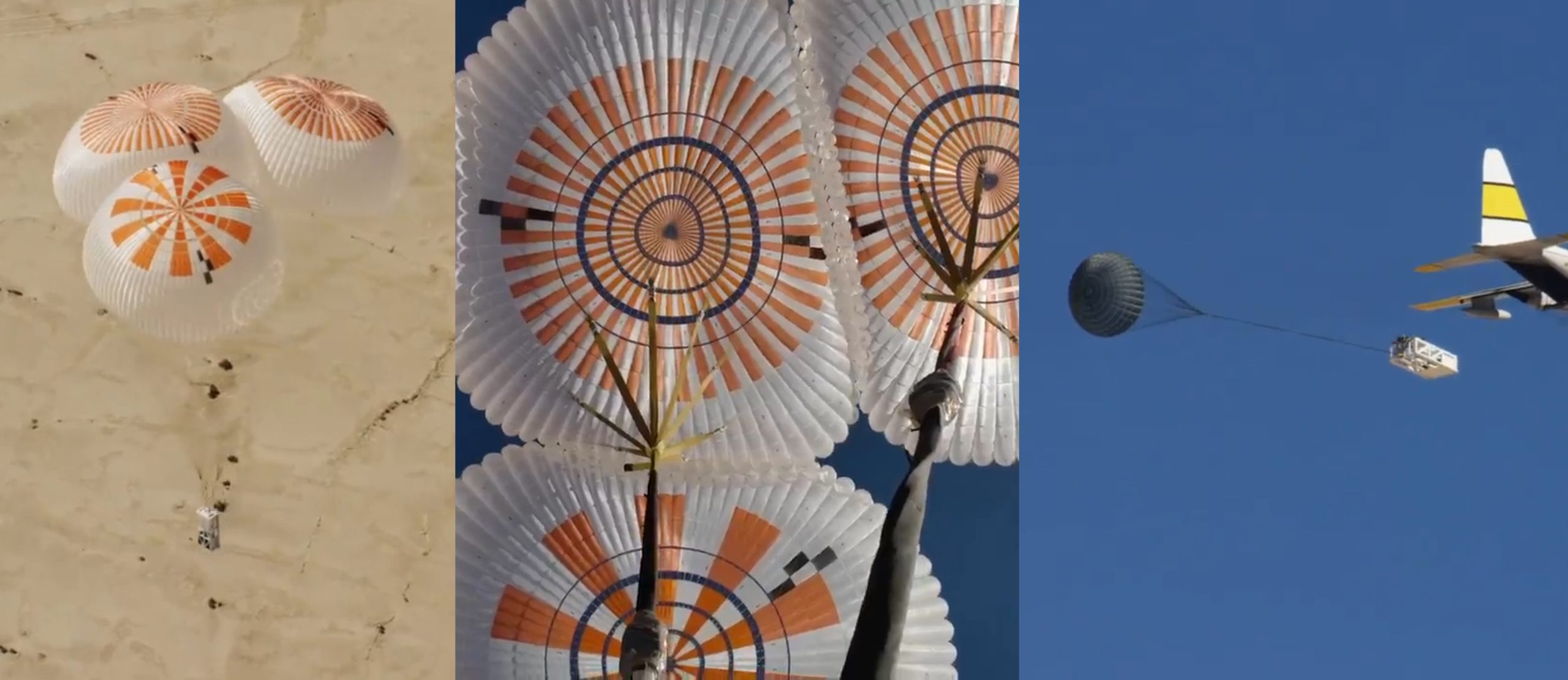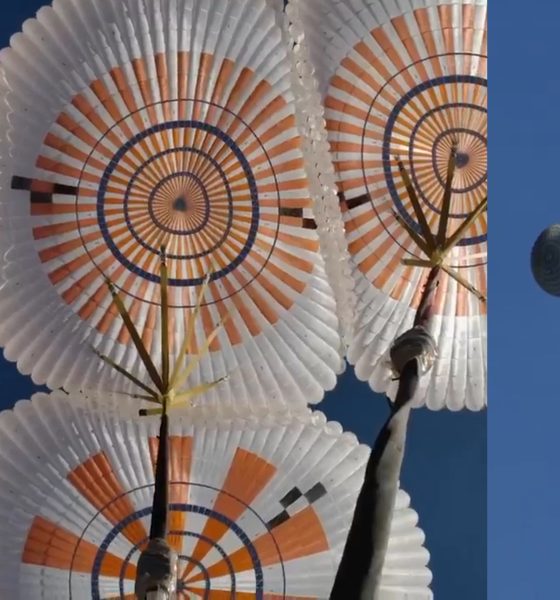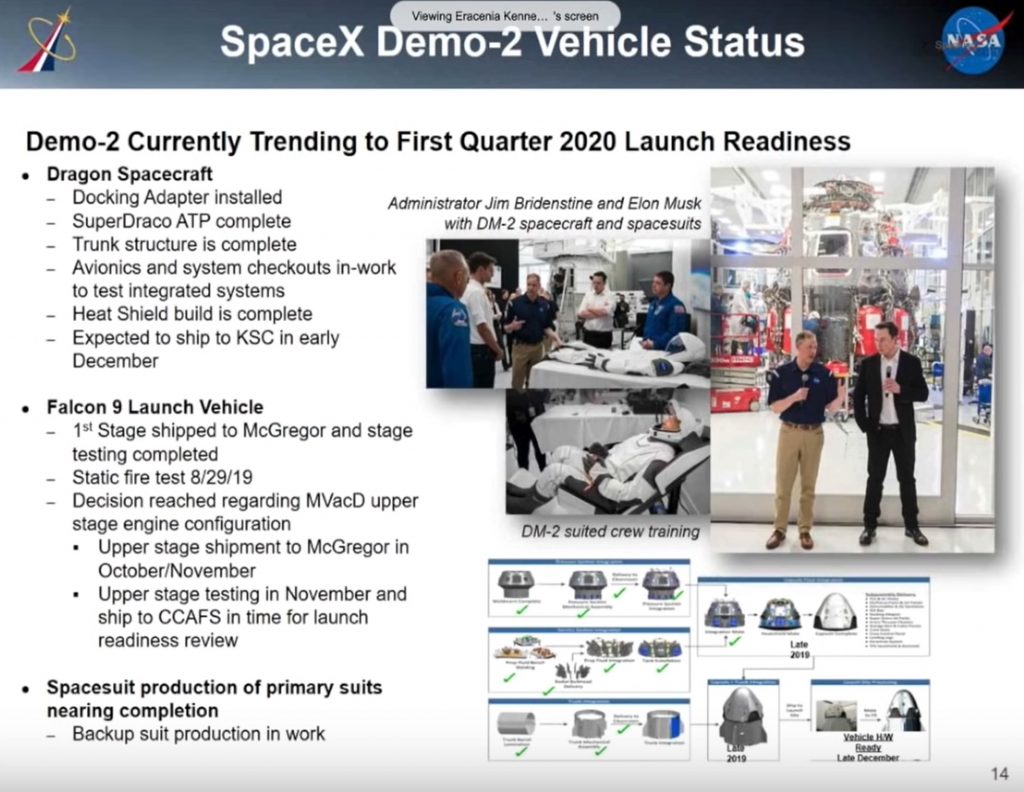

News
SpaceX says Crew Dragon parachute upgrade nailed more than a dozen tests in a row
According to SpaceX, Crew Dragon’s upgraded ‘Mk3’ parachutes have successfully completed more than a dozen tests in a row, a feat accomplished by SpaceX engineers and technicians in a single week.
Although SpaceX will likely continue to test the upgraded parachutes over the next several weeks and months, Mk3’s success up to now – including a demonstration of an emergency landing scenario – likely means that the company is well on track for NASA to certify Crew Dragon for its first astronaut launch.
Known as Demo-2, SpaceX’s first crewed demonstration mission is tentatively scheduled to launch no earlier than the first quarter of 2020 and is almost entirely dependent upon NASA (and SpaceX, to a lesser extent) completing review and qualification paperwork. On October 8th, SpaceX CEO Elon Musk indicated that SpaceX itself – including all Crew Dragon and Falcon 9 hardware – would likely be ready to launch before the end of December 2019.

During an October 30th briefing from Commercial Crew Program manager Kathy Lueders, NASA essentially confirmed Musk’s estimate for Crew Dragon hardware readiness, estimating that the Crew Dragon Demo-2 spacecraft will be ready for flight around the end of December. The mission’s Falcon 9 booster has also completed testing in Texas, while SpaceX plans to ship the Falcon 9 upper stage to Texas for acceptance testing in November.
In recent months, NASA has indicated that the parachute systems of both Boeing’s Starliner and SpaceX’s Crew Dragon were a prominent concern after chute failures occurred on several occasions. In response, SpaceX redesigned Crew Dragon’s parachutes – supplied by Airborne Systems – to account for the failure modes experience, while also advancing the state of the art of computer modeling of parachute deployment and behavior.
In response to past failures, SpaceX chose to further upgrade and strengthen Crew Dragon’s parachutes, moving to a ‘Mk3’ variant with stronger Zylon risers (strips connecting Dragon to its parachute rigging), among other tweaks. Notably, in an October 2019 press conference with Musk, NASA administrator Jim Bridenstine noted that SpaceX had plans to field and test those Mk3 parachutes at least 10 times before the end of 2019.
“We could see as many as 10 drop tests between now and the end of the year and depending on how the next 10 drop tests go, we will know how many more drops tests we are going to add.”
Jim Bridenstine, October 10th, 2019
In fact, during the latest stage of testing, SpaceX says it successfully completed thirteen consecutive tests of Crew Dragon’s new Mk3 parachutes, all of which were completed in less than two weeks. This essentially blows Bridenstine’s expectations out of the water, as SpaceX has surpassed his predicted 10 tests and done so barely three weeks into the tentative 12-week window he set. SpaceX now has plenty of time to either continue testing Crew Dragon’s parachutes or refocus its efforts on other equally important qualification challenges.
Prior to those thirteen consecutive successes, SpaceX suffered two failures during single-parachute Mk3 testing. The first two development tests of the Mk 3 design used loads much higher than the parachutes would ever see in operation in an effort to better understand overall design margins and system performance. After a period of rapid iteration with parachute provider Airborne Systems, the faults responsible for those two stress-test failures were resolved and subsequent drop tests confirmed that Mk3’s suspension lines – the numerous lines connecting the parachute to Crew Dragon – are far stronger than those on Mk2.
Perhaps most crucially, the most recent test – shown in the video shared by SpaceX on November 3rd – was the first multi-chute Mk3 demonstration and simultaneously proved that Crew Dragon will be able to safely land its astronaut passengers even if one of the spacecraft’s four parachutes fail to deploy. Despite those consecutive successes, SpaceX and Airborne will continue testing Mk3 parachutes as rapidly as possible and aim to provide NASA the data it needs to qualify Crew Dragon’s parachutes for crewed flight before the end of 2019.
Either way, the next several months are set to be a frenetic period for NASA’s Commercial Crew Program. As early as November 4th, Boeing aims to attempt a pad abort test of its Starliner spacecraft, while SpaceX is set to static fire a Crew Dragon capsule on November 6th. If both tests are successful, SpaceX aims to launch Crew Dragon’s In-Flight Abort (IFA) test in early-December, while Boeing hopes to launch Starliner on its first uncrewed Orbital Flight Test (OFT) no earlier than December 17th.
Check out Teslarati’s Marketplace! We offer Tesla accessories, including for the Tesla Cybertruck and Tesla Model 3.

News
Tesla FSD fleet is nearing 7 billion total miles, including 2.5 billion city miles
As can be seen on Tesla’s official FSD webpage, vehicles equipped with the system have now navigated over 6.99 billion miles.

Tesla’s Full Self-Driving (Supervised) fleet is closing in on almost 7 billion total miles driven, as per data posted by the company on its official FSD webpage.
These figures hint at the massive scale of data fueling Tesla’s rapid FSD improvements, which have been quite notable as of late.
FSD mileage milestones
As can be seen on Tesla’s official FSD webpage, vehicles equipped with the system have now navigated over 6.99 billion miles. Tesla owner and avid FSD tester Whole Mars Catalog also shared a screenshot indicating that from the nearly 7 billion miles traveled by the FSD fleet, more than 2.5 billion miles were driven inside cities.
City miles are particularly valuable for complex urban scenarios like unprotected turns, pedestrian interactions, and traffic lights. This is also the difference-maker for FSD, as only complex solutions, such as Waymo’s self-driving taxis, operate similarly on inner-city streets. And even then, incidents such as the San Francisco blackouts have proven challenging for sensor-rich vehicles like Waymos.
Tesla’s data edge
Tesla has a number of advantages in the autonomous vehicle sector, one of which is the size of its fleet and the number of vehicles training FSD on real-world roads. Tesla’s nearly 7 billion FSD miles then allow the company to roll out updates that make its vehicles behave like they are being driven by experienced drivers, even if they are operating on their own.
So notable are Tesla’s improvements to FSD that NVIDIA Director of Robotics Jim Fan, after experiencing FSD v14, noted that the system is the first AI that passes what he described as a “Physical Turing Test.”
“Despite knowing exactly how robot learning works, I still find it magical watching the steering wheel turn by itself. First it feels surreal, next it becomes routine. Then, like the smartphone, taking it away actively hurts. This is how humanity gets rewired and glued to god-like technologies,” Fan wrote in a post on X.
News
Tesla starts showing how FSD will change lives in Europe
Local officials tested the system on narrow country roads and were impressed by FSD’s smooth, human-like driving, with some calling the service a game-changer for everyday life in areas that are far from urban centers.

Tesla has launched Europe’s first public shuttle service using Full Self-Driving (Supervised) in the rural Eifelkreis Bitburg-Prüm region of Germany, demonstrating how the technology can restore independence and mobility for people who struggle with limited transport options.
Local officials tested the system on narrow country roads and were impressed by FSD’s smooth, human-like driving, with some calling the service a game-changer for everyday life in areas that are far from urban centers.
Officials see real impact on rural residents
Arzfeld Mayor Johannes Kuhl and District Administrator Andreas Kruppert personally tested the Tesla shuttle service. This allowed them to see just how well FSD navigated winding lanes and rural roads confidently. Kruppert said, “Autonomous driving sounds like science fiction to many, but we simply see here that it works totally well in rural regions too.” Kuhl, for his part, also noted that FSD “feels like a very experienced driver.”
The pilot complements the area’s “Citizen Bus” program, which provides on-demand rides for elderly residents who can no longer drive themselves. Tesla Europe shared a video of a demonstration of the service, highlighting how FSD gives people their freedom back, even in places where public transport is not as prevalent.
What the Ministry for Economic Affairs and Transport says
Rhineland-Palatinate’s Minister Daniela Schmitt supported the project, praising the collaboration that made this “first of its kind in Europe” possible. As per the ministry, the rural rollout for the service shows FSD’s potential beyond major cities, and it delivers tangible benefits like grocery runs, doctor visits, and social connections for isolated residents.
“Reliable and flexible mobility is especially vital in rural areas. With the launch of a shuttle service using self-driving vehicles (FSD supervised) by Tesla in the Eifelkreis Bitburg-Prüm, an innovative pilot project is now getting underway that complements local community bus services. It is the first project of its kind in Europe.
“The result is a real gain for rural mobility: greater accessibility, more flexibility and tangible benefits for everyday life. A strong signal for innovation, cooperation and future-oriented mobility beyond urban centers,” the ministry wrote in a LinkedIn post.
News
Tesla China quietly posts Robotaxi-related job listing
Tesla China is currently seeking a Low Voltage Electrical Engineer to work on circuit board design for the company’s autonomous vehicles.

Tesla has posted a new job listing in Shanghai explicitly tied to its Robotaxi program, fueling speculation that the company is preparing to launch its dedicated autonomous ride-hailing service in China.
As noted in the listing, Tesla China is currently seeking a Low Voltage Electrical Engineer to work on circuit board design for the company’s autonomous vehicles.
Robotaxi-specific role
The listing, which was shared on social media platform X by industry watcher @tslaming, suggested that Tesla China is looking to fill the role urgently. The job listing itself specifically mentions that the person hired for the role will be working on the Low Voltage Hardware team, which would design the circuit boards that would serve as the nervous system of the Robotaxi.
Key tasks for the role, as indicated in the job listing, include collaboration with PCB layout, firmware, mechanical, program management, and validation teams, among other responsibilities. The role is based in Shanghai.
China Robotaxi launch
China represents a massive potential market for robotaxis, with its dense urban centers and supportive policies in select cities. Tesla has limited permission to roll out FSD in the country, though despite this, its vehicles have been hailed as among the best in the market when it comes to autonomous features. So far, at least, it appears that China supports Tesla’s FSD and Robotaxi rollout.
This was hinted at in November, when Tesla brought the Cybercab to the 8th China International Import Expo (CIIE) in Shanghai, marking the first time that the autonomous two-seater was brought to the Asia-Pacific region. The vehicle, despite not having a release date in China, received a significant amount of interest among the event’s attendees.








